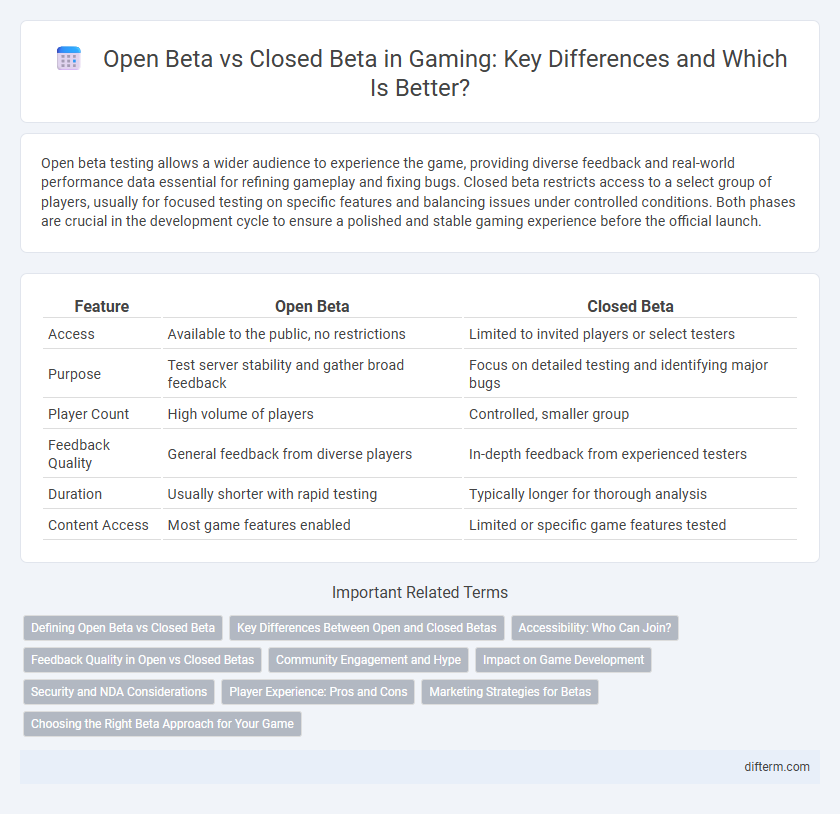Open beta testing allows a wider audience to experience the game, providing diverse feedback and real-world performance data essential for refining gameplay and fixing bugs. Closed beta restricts access to a select group of players, usually for focused testing on specific features and balancing issues under controlled conditions. Both phases are crucial in the development cycle to ensure a polished and stable gaming experience before the official launch.
Table of Comparison
| Feature | Open Beta | Closed Beta |
|---|---|---|
| Access | Available to the public, no restrictions | Limited to invited players or select testers |
| Purpose | Test server stability and gather broad feedback | Focus on detailed testing and identifying major bugs |
| Player Count | High volume of players | Controlled, smaller group |
| Feedback Quality | General feedback from diverse players | In-depth feedback from experienced testers |
| Duration | Usually shorter with rapid testing | Typically longer for thorough analysis |
| Content Access | Most game features enabled | Limited or specific game features tested |
Defining Open Beta vs Closed Beta
Open beta tests allow a broad group of players to access and evaluate a game before its official release, providing diverse feedback on gameplay, performance, and server stability. Closed beta tests restrict participation to a selected group, often via invitations or sign-ups, targeting focused feedback from dedicated testers and early adopters. These testing phases are critical for developers to identify bugs, balance game mechanics, and optimize user experience prior to launching the game to a wider audience.
Key Differences Between Open and Closed Betas
Closed betas restrict access to a limited group of testers, enabling developers to gather detailed feedback and identify critical bugs in a controlled environment, whereas open betas invite a broader audience to test the game and assess server performance under real-world conditions. Closed betas prioritize precise balancing and feature refinement with a smaller, often invited community, while open betas focus on scalability, stress testing, and wider player experience validation. The level of access control and feedback specificity are the primary distinctions influencing development stages and player engagement strategies.
Accessibility: Who Can Join?
Closed beta phases restrict access to a select group of players, typically by invitation or pre-registration, ensuring controlled testing with targeted feedback. Open beta invites a broader audience, allowing any player to participate and experience the game ahead of its official release. Accessibility in open betas fosters diverse player engagement, while closed betas prioritize focused evaluation and refinement.
Feedback Quality in Open vs Closed Betas
Closed betas typically yield higher feedback quality due to a selective group of experienced testers who provide detailed, actionable insights. Open betas attract a larger, more diverse player base, often resulting in varied but less focused feedback that may include general impressions and less technical detail. Developers leverage closed beta feedback for in-depth problem solving, while open beta feedback helps identify broad issues and usability concerns across different hardware and play styles.
Community Engagement and Hype
Closed beta tests foster exclusive community engagement by involving a limited number of players, creating a sense of privilege and dedicated feedback loops critical for early game refinement. Open beta phases amplify hype by granting wider access to thousands of gamers, generating broad social media buzz and real-time stress testing across diverse hardware configurations. Effective management of both beta types balances controlled feedback with scalable excitement, optimizing game launch success.
Impact on Game Development
Open beta testing provides developers with extensive real-world data and diverse user feedback, enabling rapid identification and resolution of bugs, balance issues, and server performance challenges. Closed beta limits participants to a selective group, allowing for focused, confidential testing that refines core mechanics and minimizes risk of premature exposure. Both approaches significantly influence game stability, user experience, and final release quality by informing iterative improvements based on player interaction patterns and system stress tests.
Security and NDA Considerations
Closed beta tests enforce strict NDA agreements to protect game content and intellectual property, ensuring participants cannot disclose sensitive information. Security measures are heightened during closed betas, limiting access to a select group of trusted players to prevent leaks and unauthorized distribution. Open beta phases reduce such restrictions, prioritizing broader user feedback over stringent confidentiality and security protocols.
Player Experience: Pros and Cons
Closed beta testing offers a controlled environment where developers gather detailed player feedback and identify critical bugs, enhancing overall game stability before public release. Open beta allows a broader player base to experience the game, providing diverse input and stress-testing servers under real-world conditions, but it may expose unfinished features and lead to inconsistent gameplay experiences. Both phases are essential for refining game mechanics, balancing difficulty, and optimizing performance, directly impacting player satisfaction and retention.
Marketing Strategies for Betas
Closed beta tests target a select group of players, generating exclusive hype and leveraging word-of-mouth marketing to build anticipation through scarcity and personalized feedback. Open beta phases expand access to a broader audience, maximizing user acquisition and collecting diverse gameplay data to optimize in-game marketing campaigns and monetization strategies. Combining closed and open betas allows developers to create layered marketing funnels, balancing exclusivity with mass exposure to sustain momentum before launch.
Choosing the Right Beta Approach for Your Game
Selecting between open beta and closed beta hinges on your game's testing needs and target audience size; closed betas offer controlled feedback from select players to identify critical bugs and gameplay issues early. Open betas provide broader player engagement, stress-testing servers and gathering diverse user data while building hype for launch. Prioritizing closed beta is ideal for feature refinement, whereas open beta suits scalability assessment and community building.
open beta vs closed beta Infographic

 difterm.com
difterm.com